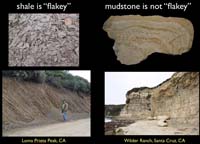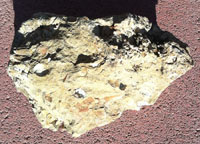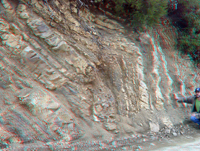6.12: Clastic Sedimentary Rocks
- Page ID
- 10229
\( \newcommand{\vecs}[1]{\overset { \scriptstyle \rightharpoonup} {\mathbf{#1}} } \)
\( \newcommand{\vecd}[1]{\overset{-\!-\!\rightharpoonup}{\vphantom{a}\smash {#1}}} \)
\( \newcommand{\dsum}{\displaystyle\sum\limits} \)
\( \newcommand{\dint}{\displaystyle\int\limits} \)
\( \newcommand{\dlim}{\displaystyle\lim\limits} \)
\( \newcommand{\id}{\mathrm{id}}\) \( \newcommand{\Span}{\mathrm{span}}\)
( \newcommand{\kernel}{\mathrm{null}\,}\) \( \newcommand{\range}{\mathrm{range}\,}\)
\( \newcommand{\RealPart}{\mathrm{Re}}\) \( \newcommand{\ImaginaryPart}{\mathrm{Im}}\)
\( \newcommand{\Argument}{\mathrm{Arg}}\) \( \newcommand{\norm}[1]{\| #1 \|}\)
\( \newcommand{\inner}[2]{\langle #1, #2 \rangle}\)
\( \newcommand{\Span}{\mathrm{span}}\)
\( \newcommand{\id}{\mathrm{id}}\)
\( \newcommand{\Span}{\mathrm{span}}\)
\( \newcommand{\kernel}{\mathrm{null}\,}\)
\( \newcommand{\range}{\mathrm{range}\,}\)
\( \newcommand{\RealPart}{\mathrm{Re}}\)
\( \newcommand{\ImaginaryPart}{\mathrm{Im}}\)
\( \newcommand{\Argument}{\mathrm{Arg}}\)
\( \newcommand{\norm}[1]{\| #1 \|}\)
\( \newcommand{\inner}[2]{\langle #1, #2 \rangle}\)
\( \newcommand{\Span}{\mathrm{span}}\) \( \newcommand{\AA}{\unicode[.8,0]{x212B}}\)
\( \newcommand{\vectorA}[1]{\vec{#1}} % arrow\)
\( \newcommand{\vectorAt}[1]{\vec{\text{#1}}} % arrow\)
\( \newcommand{\vectorB}[1]{\overset { \scriptstyle \rightharpoonup} {\mathbf{#1}} } \)
\( \newcommand{\vectorC}[1]{\textbf{#1}} \)
\( \newcommand{\vectorD}[1]{\overrightarrow{#1}} \)
\( \newcommand{\vectorDt}[1]{\overrightarrow{\text{#1}}} \)
\( \newcommand{\vectE}[1]{\overset{-\!-\!\rightharpoonup}{\vphantom{a}\smash{\mathbf {#1}}}} \)
\( \newcommand{\vecs}[1]{\overset { \scriptstyle \rightharpoonup} {\mathbf{#1}} } \)
\(\newcommand{\longvect}{\overrightarrow}\)
\( \newcommand{\vecd}[1]{\overset{-\!-\!\rightharpoonup}{\vphantom{a}\smash {#1}}} \)
\(\newcommand{\avec}{\mathbf a}\) \(\newcommand{\bvec}{\mathbf b}\) \(\newcommand{\cvec}{\mathbf c}\) \(\newcommand{\dvec}{\mathbf d}\) \(\newcommand{\dtil}{\widetilde{\mathbf d}}\) \(\newcommand{\evec}{\mathbf e}\) \(\newcommand{\fvec}{\mathbf f}\) \(\newcommand{\nvec}{\mathbf n}\) \(\newcommand{\pvec}{\mathbf p}\) \(\newcommand{\qvec}{\mathbf q}\) \(\newcommand{\svec}{\mathbf s}\) \(\newcommand{\tvec}{\mathbf t}\) \(\newcommand{\uvec}{\mathbf u}\) \(\newcommand{\vvec}{\mathbf v}\) \(\newcommand{\wvec}{\mathbf w}\) \(\newcommand{\xvec}{\mathbf x}\) \(\newcommand{\yvec}{\mathbf y}\) \(\newcommand{\zvec}{\mathbf z}\) \(\newcommand{\rvec}{\mathbf r}\) \(\newcommand{\mvec}{\mathbf m}\) \(\newcommand{\zerovec}{\mathbf 0}\) \(\newcommand{\onevec}{\mathbf 1}\) \(\newcommand{\real}{\mathbb R}\) \(\newcommand{\twovec}[2]{\left[\begin{array}{r}#1 \\ #2 \end{array}\right]}\) \(\newcommand{\ctwovec}[2]{\left[\begin{array}{c}#1 \\ #2 \end{array}\right]}\) \(\newcommand{\threevec}[3]{\left[\begin{array}{r}#1 \\ #2 \\ #3 \end{array}\right]}\) \(\newcommand{\cthreevec}[3]{\left[\begin{array}{c}#1 \\ #2 \\ #3 \end{array}\right]}\) \(\newcommand{\fourvec}[4]{\left[\begin{array}{r}#1 \\ #2 \\ #3 \\ #4 \end{array}\right]}\) \(\newcommand{\cfourvec}[4]{\left[\begin{array}{c}#1 \\ #2 \\ #3 \\ #4 \end{array}\right]}\) \(\newcommand{\fivevec}[5]{\left[\begin{array}{r}#1 \\ #2 \\ #3 \\ #4 \\ #5 \\ \end{array}\right]}\) \(\newcommand{\cfivevec}[5]{\left[\begin{array}{c}#1 \\ #2 \\ #3 \\ #4 \\ #5 \\ \end{array}\right]}\) \(\newcommand{\mattwo}[4]{\left[\begin{array}{rr}#1 \amp #2 \\ #3 \amp #4 \\ \end{array}\right]}\) \(\newcommand{\laspan}[1]{\text{Span}\{#1\}}\) \(\newcommand{\bcal}{\cal B}\) \(\newcommand{\ccal}{\cal C}\) \(\newcommand{\scal}{\cal S}\) \(\newcommand{\wcal}{\cal W}\) \(\newcommand{\ecal}{\cal E}\) \(\newcommand{\coords}[2]{\left\{#1\right\}_{#2}}\) \(\newcommand{\gray}[1]{\color{gray}{#1}}\) \(\newcommand{\lgray}[1]{\color{lightgray}{#1}}\) \(\newcommand{\rank}{\operatorname{rank}}\) \(\newcommand{\row}{\text{Row}}\) \(\newcommand{\col}{\text{Col}}\) \(\renewcommand{\row}{\text{Row}}\) \(\newcommand{\nul}{\text{Nul}}\) \(\newcommand{\var}{\text{Var}}\) \(\newcommand{\corr}{\text{corr}}\) \(\newcommand{\len}[1]{\left|#1\right|}\) \(\newcommand{\bbar}{\overline{\bvec}}\) \(\newcommand{\bhat}{\widehat{\bvec}}\) \(\newcommand{\bperp}{\bvec^\perp}\) \(\newcommand{\xhat}{\widehat{\xvec}}\) \(\newcommand{\vhat}{\widehat{\vvec}}\) \(\newcommand{\uhat}{\widehat{\uvec}}\) \(\newcommand{\what}{\widehat{\wvec}}\) \(\newcommand{\Sighat}{\widehat{\Sigma}}\) \(\newcommand{\lt}{<}\) \(\newcommand{\gt}{>}\) \(\newcommand{\amp}{&}\) \(\definecolor{fillinmathshade}{gray}{0.9}\)Clastic Sedimentary Rocks
Rocks composed of grains of mineral and rock fragments derived from erosion of other rocks. Three general groups are coarse-grained, sand-size grained, and fine-grained ("mudrocks").
Coarse-grained sediments and sedimentary rocks
Gravel is rock particles that have been moved by moving water. Gravel usually consists of a mix of the more durable and most abundant rock types in the sediment source areas (Figure 6.41). Gravel deposits typically occur along stream valleys close to mountainous source areas and along rocky coastlines with high wave action.
Conglomerate is a sedimentary rock composed of cemented gravel. It consists of rounded to sub-angular fragments (larger than 2 mm in diameter) set in a fine-grained matrix of sand or silt, and commonly cemented by calcium carbonate, iron oxide, silica, or hardened clay; the consolidated equivalent to gravel (Figures 6-42). The composition of grave reflects the rocks the general composition in the area where it comes from.
 |
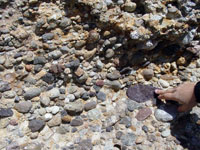 |
| Figure 6.41. Wave action creates well rounded and sorted gravel. | Figure 6.42. Conglomerate formed from an ancient gravel deposit. |
Sand-size-grained sediments and sedimentary rocks
Sand goes through degrees of refinement at it moves away from source areas. Sand deposits near mountain ranges may be enriched in feldspars. Volcanic regions may produce sand enriched in dark minerals. "Mature" sand that has traveled long distances in streams, blown by wind, or worked and reworked by waves will be enriched in quartz and individual grains will be very well rounded and well sorted (see below). Large sand deposit accumulate along stream valleys, on beaches, barrier islands, and offshore bars, and in dune fields in coastal areas and in desert environments.
Sandstone is a sedimentary rock formed by the consolidation and compaction of sand and held together by a natural cement, such as silica, calcite, and iron-oxide minerals (Figure 6.44). Most sandstone is dominated by the minerals quartz.
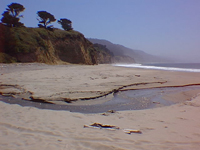 |
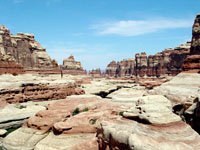 |
| Figure 6.43. Sand is winnowed (sorted) and accumulates on a beach by wave action. | Figure 6.44. Sandstone outcrops exposed in Utah's Canyonlands National Park |
Fine-grained sediments and sedimentary rocks ("Mudrocks")
Mud is a general term lumping together sediments consisting of a mix of clay, silt, and may contain sand. Mud is usually an unsorted mix of fine grain materials. Mud accumulates in quiet water settings separated from where coarser materials have settled out elsewhere (Figure 6.46). Most soil is mud. Mud-rich accumulations are common in river delta regions, swampy coastal regions, tidal flats, and in lake and deep water settings.
Mudstone is a fine-grained sedimentary rock formed from the compaction and cementation (lithification) of muddy sediments rich in silt (but may include percentages of fine sand and clay).
Shale is a soft, finely stratified sedimentary rock that formed from consolidated mud rich in clay minerals and can be split easily into fragile plates, such as along bedding plains. Shale forms from the compaction of sediment dominated by clays.
Clays are composed of any microscopic mineral particles. Most dust is clay sized particles. However, there are several types of clay minerals. Clay minerals are any of various hydrated aluminum silicates that have a fine crystalline structure and are components of clay (sediment). Clay minerals form from the weathering of feldspars and other silicate minerals and are the dominant sediment found on earth.
Graywacke (or graywacke or grauwacke, a German word signifying a gray, earthy rock) is a variety of sandstone or mudrock generally characterized by its dark color and poorly sorted angular grains including a mix of quartz, feldspar, dark mafic minerals, and tiny rock fragments cemented in a compact, clay-fine matrix. Generally, graywacke is a featureless dirty-looking, dark brown or gray sandstone or silty mudstone. Graywacke is common in active continental margin regions such as along coastal California (Figures 6-49 and 6-50).





